
The Alpha Particle or Helium 4 Nucleus
Summing up of previous sections covering the alpha particle
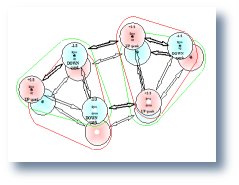 The alpha particle or helium 4 nucleus is very stable. The figure to
the right shows two protons (outlined in red, each containing two up
quarks, red, and one down quark, blue) and two neutrons (outlined in
green, each containing two down quarks, blue, and one up quark, red).
The alpha particle or helium 4 nucleus is very stable. The figure to
the right shows two protons (outlined in red, each containing two up
quarks, red, and one down quark, blue) and two neutrons (outlined in
green, each containing two down quarks, blue, and one up quark, red).
The magnetic and electric fields of all twelve quarks of the four nucleons in the alpha particle are lined up so that there is maximum magnetic and electrical coupling which provides maximum stability to the alpha particle. The alignment of the magnetic fields results in the alpha particle having zero spin and zero magnetic dipole.
This arraignment of quarks in the nucleons forms an alpha particle has the approximate shape of a flattened ovoid. The following illustrations show how two protons (red outline) and two neutrons (green outlines) might form an ovoid alpha (purple outline). There are two illustrations present the ovoid of the alpha from a top perspectives and a side prospective.

Examining the alpha particle from the perspective of how it will fit into the structure of the nucleus and attach with other nucleons. The structure ultimately takes on a six sided, flattened shape. The illustration below indicates how the alpha approximates a six sided elongated structure where the ends are formed by two 60 degree wedges or capping triangles. Attachment occurs between nucleons by joining on one of the three sides of a nucleon. Thus the structure builds by adding to angled ends of the alpha, not at the middle where two nucleons are attach to each other. Triangular attachments result in an elementary six sided structure.
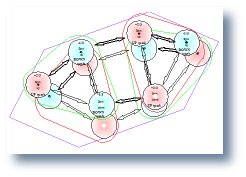
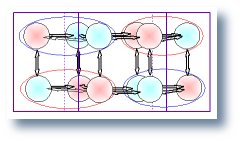
 The ZOME model shown to the right further illustrates the six sided
structure of the alpha particle. This six sided form is the dominant
shape that controls the basic structure of the nuclear lattice. The
black nodes represent up quarks and the white nodes represent down
quarks. The nodes connected with blue struts represent two protons,
and the nodes connected with white struts represent two neutrons.
The yellow and red struts used here represent the electrical and
other cross connections between the quarks contained in the protons
and neutrons.
The ZOME model shown to the right further illustrates the six sided
structure of the alpha particle. This six sided form is the dominant
shape that controls the basic structure of the nuclear lattice. The
black nodes represent up quarks and the white nodes represent down
quarks. The nodes connected with blue struts represent two protons,
and the nodes connected with white struts represent two neutrons.
The yellow and red struts used here represent the electrical and
other cross connections between the quarks contained in the protons
and neutrons.
There are two obvious, if not more, possible ways to visualize the assembly of an alpha particle. The two methods illustrated here are for information purposes to aid the reader in visualizing the final assembly or arrangement of the alpha particle.
The helium nucleus or alpha particle can be visualized as being composed of two prism shaped deuterons each the mirror image of the other. A tinker toy model of two deuterons coming together is depicted in the following figure.
- The red spheres represent up quarks.
- The blue spheres represent down quarks.
- The black arrows represent color force binding the quarks within the protons and neutrons.
- The red arrows indicate electrical coupling between the quarks from one nucleon to another nucleon.
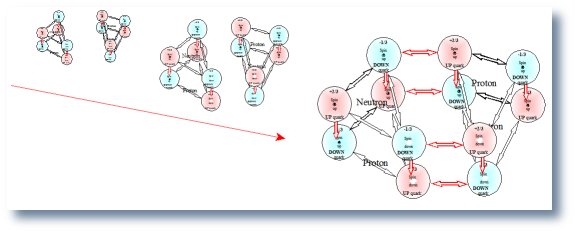
The alpha particle forms a stable elongated hexagonal crystalline structure based on the electric links between alternating positively and negatively charged quarks and the interlinking magnetic dipoles.
The nuclear quark interactions and structure does not alter the quark structure of the protons or neutrons in anyway. This illustrates vividly why the resulting alpha structure is such a stable form. The twelve quark arrangements of the alpha particles are such that the two protons and two neutrons are diagonally opposed in a manor where the protons do not touch each other, nor do the neutrons touch each other.
A second method for visualization of how the alpha particle structure is arranged can be demonstrated using two six sided plates that are coupled together from two hexagonal flat prism crystalline equivalent arrangement like the tinker toy model shown below. This pattern of alpha building occurs at the top or bottom of larger nuclei. In this arrangement the upper layer has three up quarks and three down quarks. This six sided top plate structure alternates up and down quarks, and the bottom plate, generally part of the larger nucleus also alternates down and up quarks in a mirror image such that there are always up-down quark pairs in vertical and horizontal direction that eventually becomes an internally stabilized alpha structure. The final result is the same arrangement as previously illustrated which is symmetrical with attractive coupling between all of the component quarks.
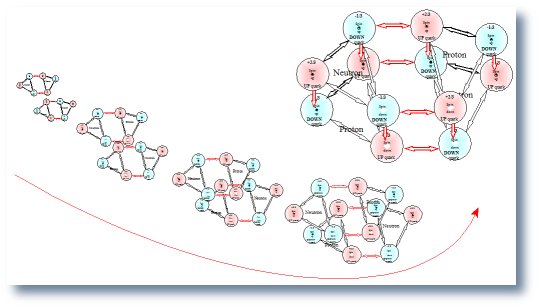
The structure for the alpha particles can almost be considered crystalline like in state. The sections on the "Deuteron & Alpha Steps� illustrates how the progression of stable nuclei can be visualized as deuteron or alpha building. The table of stable elements shows a construct similar to what would be created by a long chain organic polymer or the deposition pattern of a crystalline sub-straight. The pattern of stable nuclides is indicative of filling crystalline subsets as well as building a larger crystalline set. This statement will become clearer as you proceed.